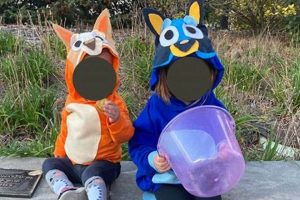The creation of homemade attire for young individuals portraying witches involves crafting garments and accessories, often utilizing readily available materials and simplified construction techniques. An example includes fashioning a pointed hat from cardboard and decorating it with felt stars, or sewing a simple A-line dress from repurposed fabric.
Constructing these outfits offers several advantages. It fosters creativity in both the maker and the child, promoting problem-solving and imaginative play. Furthermore, it presents a cost-effective alternative to purchasing pre-made options and encourages sustainable practices through the reuse of materials. Historically, homemade costumes have been a tradition, allowing for unique expression and adaptation to available resources.
Subsequent sections will delve into specific techniques for designing and assembling such ensembles, covering hat construction, dress patterns, accessory creation, and safety considerations for young wearers. Ideas for personalization and incorporating found objects will also be explored.
Essential Guidance for Crafting Children’s Witch Attire
The following recommendations aim to assist in the construction of safe, aesthetically pleasing, and durable witch costumes for children, emphasizing resourcefulness and attention to detail.
Tip 1: Fabric Selection. Prioritize non-flammable or flame-retardant materials. Natural fibers like cotton can be treated, but synthetic blends with inherent fire resistance are preferable. This is crucial for safety, especially around open flames.
Tip 2: Simplified Patterns. Opt for patterns with minimal seams and straightforward construction techniques. A basic A-line dress or poncho design is easier to execute than complex garments, particularly for novice sewers.
Tip 3: Hat Stability. Reinforce the brim of the witch’s hat with sturdy cardboard or buckram. This prevents the hat from collapsing and maintains its shape throughout wear. Consider adding an elastic chin strap for secure placement.
Tip 4: Safe Accessories. Avoid small, detachable accessories that could pose a choking hazard. If embellishments are necessary, securely affix them with strong adhesive or by sewing them directly onto the garment.
Tip 5: Wand Construction. Utilize lightweight, non-splintering materials for wands, such as dowels or plastic rods. Ensure the end is blunt and smooth to prevent injury. Decorative elements should be firmly attached.
Tip 6: Size Considerations. Allow for ease of movement within the costume. Overly tight or restrictive garments can hinder a childs ability to play and participate in activities comfortably. Err on the side of slightly larger sizing.
Tip 7: Detail Incorporation. Enhance the costume with simple details such as ribbon trims, felt appliques, or painted designs. These additions can add visual interest without requiring complex sewing or crafting skills.
These guidelines emphasize safety, simplicity, and durability, resulting in witch attire that is both engaging and practical for children’s activities.
The subsequent segment will address specific design variations and opportunities for personalization of childrens witch costumes.
1. Fabric Safety
The selection of appropriate fabrics is a critical component in the successful creation of safe attire for children, particularly when constructing homemade costumes. When engaging in a DIY children’s witch costume project, fabric safety directly impacts the child’s well-being. Fabrics that are readily flammable pose a significant hazard, especially during activities such as Halloween celebrations where exposure to open flames from candles or other sources is possible. The use of materials lacking fire-resistant properties can rapidly lead to costume ignition and potential burn injuries. For example, a loosely woven cotton gauze, while visually appealing for a ghostly effect, would ignite rapidly if exposed to a flame, unlike a treated polyester blend.
The consequences of neglecting fabric safety extend beyond immediate physical danger. In the event of an accident, the rapid spread of flames associated with unsuitable fabrics can cause panic and hinder attempts to extinguish the fire quickly. The discomfort and potential long-term health implications resulting from burn injuries can also significantly impact the child’s well-being and necessitate extensive medical intervention. Practical considerations include understanding fabric composition, specifically the inherent flammability of various materials. Testing fabric scraps with a controlled flame source prior to costume construction can offer a rudimentary assessment of fire resistance. Choosing tightly woven, heavier fabrics rather than light, airy materials can provide a degree of protection.
In summary, fabric safety is not merely an aesthetic consideration but a fundamental prerequisite for any DIY costume endeavor intended for children. Understanding the inherent risks associated with flammable fabrics and implementing preventive measures, such as selecting fire-resistant materials or applying flame-retardant treatments, is essential. The challenges lie in balancing visual appeal with safety requirements, but prioritizing the child’s protection remains paramount, requiring a knowledgeable and responsible approach to material selection and costume design.
2. Simplified Sewing
The creation of homemade witch attire for young individuals frequently necessitates the application of simplified sewing techniques. The relationship between simplified sewing and the construction of a DIY children’s witch costume is causal: accessible and straightforward sewing methods enable a greater number of individuals, regardless of prior experience, to successfully complete the project. For example, a parent with minimal sewing skills might be intimidated by complex patterns requiring advanced techniques like darts, linings, or set-in sleeves. By utilizing simpler methods, such as straight seams and elastic casings, a basic yet functional garment can be readily produced.
Simplified sewing assumes considerable importance within the context of DIY projects aimed at children. It directly impacts the project’s feasibility and the creator’s likelihood of success. Without accessible sewing methods, the project becomes unduly difficult, potentially discouraging engagement and resulting in unfinished or substandard costumes. Examples of simplified sewing techniques in this context include utilizing pre-existing garments as patterns, employing fusible webbing for hem application instead of traditional stitching, and opting for elastic waistbands over zippers or buttons. The practical significance of understanding this relationship lies in enabling creators to tailor their approach to their skill level, increasing the likelihood of a positive and rewarding experien
ce.
In summation, simplified sewing represents a foundational element in the successful creation of homemade witch costumes for children. This approach ensures accessibility, promotes engagement, and increases the likelihood of achieving a satisfactory final product. The key insights involve recognizing the causal relationship, understanding the importance of skill-appropriate techniques, and prioritizing practicality over complexity. The challenge resides in balancing simplicity with aesthetic appeal, but by focusing on core elements and utilizing accessible methods, a rewarding and successful outcome can be achieved.
3. Hat Structure
The structural integrity of a witch’s hat is a fundamental consideration when constructing a do-it-yourself (DIY) children’s witch costume. The hat is often a defining element of the costume, and its form significantly contributes to the overall aesthetic and wearability.
- Cone Stability
The primary component of a witch’s hat is the cone. The stability of this cone depends on the material used and the method of construction. Cardboard provides rigidity but may be prone to creasing or collapsing if not adequately reinforced. Felt, while flexible, requires an internal support structure to maintain its conical shape. Improperly constructed cones can droop, detracting from the costume’s visual appeal and potentially obstructing the child’s vision.
- Brim Support
The brim of the witch’s hat extends outward from the base of the cone. Insufficient brim support can result in sagging or warping, particularly when constructed from lightweight materials. Stiffening agents such as buckram or interfacing can be incorporated to maintain the brim’s intended shape. A well-supported brim contributes to the hat’s structural integrity and enhances its overall appearance.
- Attachment Security
The method of attachment between the cone and the brim is critical. A weak connection can lead to separation, especially during active play. Strong adhesives, reinforced stitching, or a combination of both are necessary to ensure a secure and durable bond. The selected attachment method should be appropriate for the materials used and capable of withstanding the stresses of wear.
- Size and Proportion
The dimensions of the hat, including the height of the cone and the width of the brim, must be proportional to the child’s head size and overall costume. An excessively large or small hat can appear disproportionate and affect the child’s comfort. Accurate measurements and careful consideration of the hat’s overall scale are essential for achieving a visually pleasing and wearable result.
These structural considerations directly impact the success of the DIY children’s witch costume. A well-constructed hat enhances the costume’s visual appeal, ensures its durability, and contributes to the child’s overall enjoyment of wearing it. Attention to detail in each of these areas will yield a superior final product.
4. Secure Accessories
The incorporation of accessories is a common practice in the creation of homemade witch costumes for children. The secure attachment of these accessories is a critical safety consideration that directly impacts the well-being of the wearer.
- Attachment Methods
The chosen method for attaching accessories, such as stars, buckles, or decorative spiders, must be robust enough to withstand the rigors of active wear. Glue alone may not provide sufficient adhesion, particularly with fabrics that have a loose weave or that will experience repeated stress. Sewing accessories directly to the costume provides a more secure and durable attachment. Alternative methods, such as the use of fabric-safe adhesives combined with stitching, can also be effective. Inadequate attachment can lead to accessories detaching, creating a choking hazard for younger children.
- Material Selection
The materials used for accessories should be non-toxic and appropriate for children. Small beads, glitter, or other potentially hazardous components should be avoided, or securely encapsulated to prevent ingestion. The choice of materials directly affects the safety profile of the costume and must align with established safety standards for children’s products. For instance, using large felt shapes instead of small plastic gems reduces the choking hazard significantly.
- Size and Shape
The size and shape of accessories must be carefully considered to minimize the risk of entanglement or injury. Sharp edges or points should be avoided, or adequately covered with protective materials. Oversized accessories, while visually striking, can impede movement and increase the likelihood of tripping or falling. Smaller accessories can pose choking hazards. Balancing aesthetic appeal with safety considerations is essential.
- Durability and Longevity
The accessories should be constructed from materials that are durable and capable of withstanding repeated use. Fragile or easily broken accessories can create sharp fragments that pose a laceration hazard. The attachment points should also be reinforced to prevent loosening or detachment over time. Regular inspection of the costume and accessories is recommended to identify and address any potential safety issues.
The discussed elements highlight the importance of prioritizing safety when incorporating accessories into a homemade witch costume. Adherence to these guidelines helps ensure that the costume is not only visually appealing but also safe and suitable for children’s wear. The commitment to secure attachment, appropriate material selection, and thoughtful design contributes to a safe and enjoyable experience for the child.
5. Wand Material
The selection of appropriate materials for a wand is a crucial decision in the creation of a DIY children’s witch costume. The wand serves as a focal point for imaginative play and significantly contributes to the overall aesthetic of the costume, demanding careful consideration of safety, durability, and visual appeal.
- Wood Dowels
Wood dowels are a common choice due to their availability and ease of manipulation. Smooth, splinter-free dowels reduce the risk of injury. However, wood can be prone to breaking under stress. A suitable finish, such as non-toxic paint or varnish, enhances the dowels appearance and provides a protective layer. For example, a -inch diameter hardwood dowel, sanded smooth and coated with acrylic paint, offers a balance of sturdiness and visual appeal.
- Plastic Rods
Plastic rods offer increased durability compared to wood and are less likely to splinter. The type of plastic used should be non-toxic and free of sharp edges. Hollow plastic rods can be lightweight, making them easy for children to handle. Solid plastic rods provide greater strength. An example is a smooth PVC pipe, capped at the ends and decorated with glitter or ribbon, presenting a safe and visually engaging option.
- Cardboard Tubes
Cardboa
rd tubes, such as those from paper towels or wrapping paper, represent a cost-effective and readily available option. They are lightweight and easily decorated. However, cardboard is susceptible to bending and crushing. Reinforcement with additional layers of cardboard or a coating of glue can improve its durability. A decorated cardboard tube, embellished with foil and craft foam shapes, provides a sustainable and customizable wand material. - Natural Elements
Branches or twigs found in nature can offer a unique and rustic aesthetic. The selection of natural elements requires careful consideration of safety. Branches should be thoroughly cleaned, dried, and inspected for splinters or sharp protrusions. A sealant can be applied to protect the wood and prevent splintering. A small, smooth branch, sanded and adorned with fabric scraps and beads, creates a distinctive and environmentally conscious wand.
The selection of wand material directly influences the safety, durability, and aesthetic quality of the finished DIY children’s witch costume. Consideration of these factors allows for informed decisions, resulting in a costume that is both visually appealing and suitable for active play. Balancing affordability, accessibility, and safety ensures a rewarding and enjoyable crafting experience.
6. Appropriate Sizing
The concept of appropriate sizing is paramount in the successful execution of a do-it-yourself (DIY) children’s witch costume. Sizing directly influences the comfort, safety, and overall aesthetic of the finished garment, affecting the child’s ability to fully engage in activities while wearing the costume.
- Movement Restriction
An ill-fitting costume, particularly one that is too small, can severely restrict a child’s range of motion. Tight sleeves may impede arm movement, while a constricted bodice can inhibit breathing and physical activity. This restriction not only detracts from the child’s enjoyment but also presents a potential safety hazard, increasing the risk of trips, falls, and overheating. For example, a too-tight bodice made from non-stretch fabric limits bending and twisting.
- Safety Hazards
Incorrect sizing can create various safety hazards. Overly long skirts or robes pose a tripping risk, particularly when navigating stairs or uneven terrain. Loose or dangling fabric can become entangled in obstacles, leading to falls or injuries. Conversely, a costume that is too short may expose skin to the elements, increasing the risk of sunburn or insect bites. Long sleeves restrict child from using their hands. For instance, a robe that extends significantly beyond the ankles presents a clear tripping hazard, while a hat that is too large can obstruct vision.
- Comfort and Wearability
A comfortable costume encourages the child to wear it for extended periods, enhancing their enjoyment of the event or activity. Costumes that are too itchy, tight, or restrictive can cause discomfort and lead to the child refusing to wear it. Appropriate sizing, coupled with suitable fabric choices, is essential for maximizing comfort and wearability. A properly sized witch’s hat rests securely on the head without slipping or causing pressure, and a loose-fitting tunic made from soft cotton allows for unrestricted movement and breathability.
- Aesthetic Considerations
Appropriate sizing contributes significantly to the overall aesthetic appeal of the costume. A well-fitting garment enhances the child’s appearance and creates a more polished and professional look. Conversely, a costume that is too large or too small appears sloppy and detracts from the intended visual impact. A correctly sized witch’s dress drapes gracefully, accentuating the child’s figure without appearing constricting or baggy.
These various facets highlight the crucial role of appropriate sizing in the context of a DIY children’s witch costume. Failing to prioritize sizing considerations can compromise the costume’s safety, comfort, wearability, and aesthetic appeal. Paying meticulous attention to measurements, pattern adjustments, and fabric selection is essential for creating a costume that is both visually appealing and suitable for safe and enjoyable wear.
7. Creative Detailing
Creative detailing, in the context of a do-it-yourself children’s witch costume, represents the application of personalized design elements to enhance the visual appeal and uniqueness of the garment. It moves beyond basic construction to incorporate aesthetic features that reflect individual creativity and transform a simple costume into a distinct and memorable creation.
- Fabric Embellishments
Fabric embellishments encompass the application of additional textiles or decorative elements to the primary fabric of the costume. Examples include adding patches with felt stars, moons, or spiders; incorporating lace trim along the hem of a dress; or using fabric paint to create custom designs. These embellishments contribute to the costume’s overall aesthetic and allow for personalization based on the child’s preferences. For instance, a simple black dress can be transformed into a more intricate witch costume through the addition of velvet ribbon and sequined appliques.
- Accessory Modification
Accessory modification involves altering or enhancing pre-existing accessories to better complement the costume’s design. This may include adding feathers or beads to a witch’s hat, painting a wand with metallic colors and attaching ribbons, or creating custom shoe buckles from craft foam. Modifying accessories provides an opportunity to integrate unique details that coordinate with the overall theme. A plain black hat can be elevated with the addition of handcrafted paper bats and iridescent glitter.
- Color Palette Integration
Color palette integration extends beyond the standard black and purple associated with witch costumes. Incorporating unconventional color combinations, such as deep greens, rich browns, or even pops of bright orange or teal, can create a distinctive and eye-catching look. The strategic use of color can also enhance the costume’s overall theme, suggesting a nature witch with earthy tones or a mischievous witch with vibrant hues. Employing a gradient dye technique on the dress skirt can achieve unique blend effect.
- Texture and Material Contrast
Texture and material contrast entails combining different fabrics and materials to create visual interest and depth. This may involve pairing smooth satin with rough burlap, incorporating faux fur accents, or adding netting to create a layered effect. Contrasting textures can add dimension and complexity to the costume, elevating it beyond a simple, one-dimensional design. For example, incorporating tulle overlays on a plain fabric adds visual texture.
Creative detailing, therefore, provides a framework for transforming a rudimentary children’s witch costume into a unique and expressive piece. Through the strategic application of fabric embellishments, accessory modification, color palette integration, and texture contrast, the creator can personalize the costume to reflect individual preferences and artistic vision. These details contribute to the costume’s overall aesthetic and enhance its memorability.
Frequently Asked Questions
This section addresses common inquiries and concerns related to the creation of homemade witch costumes for children, providing informative responses grounded in safety and practicality.
Question 1: What are the primary safety considerations when constructing a witch costume for a child?
The selection of flame-retardant or treated fabrics is paramount to mitigate fire hazards. Accessories should be securely attached to prevent choking risks, and sharp edges or points on any component must be avoided. Furthermore, the costume’s sizing should allow for unrestricted movement to prevent trips and falls.
Question 2: Is it necessary to possess advanced sewing skills to create a satisfactory witch costume?
Advanced sewing skills are not mandatory. Simple patterns and construction techniques, such as straight seams and elastic waistbands, can yield an acceptable result. Utilizing pre-existing garments as templates can further simplify the process.
Question 3: What are some cost-effective alternatives to purchasing new materials for a DIY costume?
Repurposing existing fabrics, such as old clothing or bedsheets, provides a sustainable and cost-effective option. Cardboard, felt scraps, and found objects can be used to create accessories and embellishments. Local thrift stores often offer inexpensive fabrics and trims.
Question 4: How can the structural integrity of a homemade witch’s hat be ensured?
Reinforcing the hat’s cone with sturdy cardboard or buckram maintains its shape. A wide brim requires additional support to prevent sagging, achievable through interfacing or wire reinforcement. A secure attachment method is crucial to connect the cone and brim effectively.
Question 5: What are some methods for personalizing a basic witch costume?
Personalization can be achieved through the addition of fabric appliques, such as stars or moons. Custom-painted designs or the incorporation of unique accessories, such as a handcrafted wand or embellished hat, can also distinguish the costume. Experimentation with color palettes beyond traditional black and purple allows for further individual expression.
Question 6: What are the recommended cleaning and storage practices for a homemade witch costume?
The specific cleaning instructions depend on the materials used. Hand washing with mild detergent is generally recommended for delicate fabrics and embellished costumes. Proper storage in a cool, dry place, away from direct sunlight, prevents fading and damage.
In summary, crafting a safe and engaging DIY witch costume for children involves prioritizing safety through material selection and construction techniques. Simplicity, resourcefulness, and creative detailing further enhance the project’s success.
The subsequent section will explore advanced techniques for constructing more elaborate DIY witch costumes, catering to individuals with intermediate to advanced crafting skills.
Conclusion
The preceding examination of “diy childrens witch costume” has highlighted critical aspects ranging from material selection and construction techniques to safety protocols and aesthetic considerations. A successful undertaking requires a meticulous approach, balancing creativity with practicality and prioritizing the well-being of the child.
Ultimately, the decision to engage in such a project demands a commitment to responsible craftsmanship and a comprehensive understanding of the potential challenges. Through diligent planning and execution, a homemade witch costume can provide a unique and rewarding experience. It fosters creativity, promotes sustainability, and potentially establishes lasting memories.


![Groovy, Baby! Austin Powers Costume DIY Guide [Easy] The DIY Hub: Creative Crafts, Repairs & Life Hacks Groovy, Baby! Austin Powers Costume DIY Guide [Easy] | The DIY Hub: Creative Crafts, Repairs & Life Hacks](https://craftingdiycenter.com/wp-content/uploads/2025/07/th-7257-300x200.jpg)




